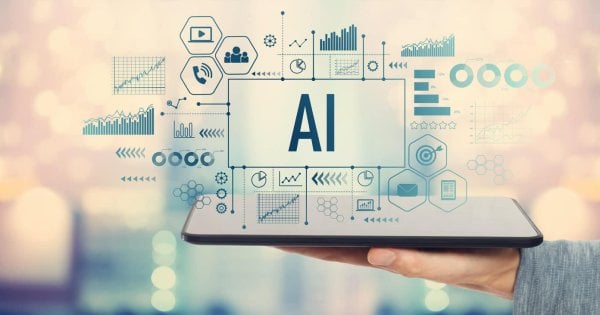A significant 23% of small businesses surveyed use artificial intelligence (AI) with 39% stating they plan to adopt AI.
Small businesses are finding innovative ways to harness AI’s abilities, from streamlining marketing efforts and enhancing customer communication to optimizing inventory management. Read on to learn more about how AI can benefit your small business.
Unpacking AI for the uninitiated.
Understanding AI and its potential may seem daunting, but clarifying its key concepts and applications can open up a world of opportunity for small businesses.
Machine Learning (ML)
ML empowers systems to learn from data, improving accuracy without explicit programming.
Natural Language Processing (NLP)
NLP allows systems to understand and respond to human language, enhancing customer service with sincerity and insight.
Robotic Process Automation (RPA)
RPA automates mundane tasks with precision, improving efficiency across sectors.
Predictive Analytics
This technology uses data and algorithms to predict future outcomes, aiding in inventory management, market trends, and client behavior analysis.
Generative AI
Generative AI revolutionizes artificial intelligence by enabling the creation of new, personalized content through machine learning.
How small businesses use AI.
Of the small businesses using AI the most common use cases include marketing activities at 56%, customer communications at 42%, inventory management at 33%, and fraud prevention at 26%.
Automation
Almost any repetitive task could be a candidate for using AI technology.
You’ve probably already used a chatbot for customer service — perhaps to receive technical support for a cable outage or make an online payment for property taxes. That chatbot and AI-powered knowledge base eliminated or reduced human time during your interaction.
One estimate says that the “average customer service call lasts six minutes. Four and a half of those minutes, or 75% percent of that time, is spent by agents manually looking for the right information.” Letting AI take its first shot at finding and presenting the information frees up customer service representatives to handle complex problems.
Email marketing software also uses AI. Remember those workflows you configured in your mail software to send customers a welcome email or invite them to use a discount code on their birthday? You can thank AI for that.
AI enables software to write email subject lines that generate better open rates or create a hyper-personalized newsletter. No more agonizing over an email subject line? Who wouldn’t cheer for that?
CRM
AI also integrates well with the customer relationship marketing (CRM) process.
For example, the wine industry realized that younger generations tend to use the Internet for wine purchases. Online merchants reaped the benefits of using AI-powered tools to help guide inexperienced customers to wines that matched their taste requirements.
AI can segment your customer list and create personalized call-to-actions based on where your customers are in their customer journey. Repeat customers may act upon a CTA that recognizes and rewards their past orders (e.g., “You enjoyed our apple pie last month. We have fresh ones available today!”). New customers may respond better if the CTA includes social proof (e.g., “Don’t you want to join 25,000 other savvy wine drinkers by signing up for our monthly newsletter?”).
Fraud Detection
AI can help detect abnormal patterns to generate alerts. Credit card companies have been using this function for a while—notifying you or even freezing your card when a suspicious transaction occurs. Your bookkeeping software might flag an entry as suspicious (it knows your car can’t hold $1000 worth of gasoline).
Microsoft suggests the benefits of detecting unusual behavior can actually go beyond stopping malicious or inaccurate transactions and potentially opening up new customer markets for your business. Their example is a plumbing-supply company that receives a large order from a non-traditional customer. A follow-up call reveals a new use case for plumbing supplies (artists need supplies, too!), and voila—a new customer market appears.
Another example is the insurance industry using AI and predictive analytics to help underwriters make risk calculations for complex customers. Would you want to guess the risk for a customer who recently completed a safe driving course but owns a Dodge charger and has a history of speeding tickets?
Manufacturing
Manufacturing businesses can use AI to help reduce the cost and time spent on quality checks (e.g., AI and robotics can check part tolerances quicker and more accurately than humans). AI can also predict equipment failure and maintenance needs reducing the “line down” syndrome that means lost revenue.
Inventory Management through AI
One compelling use case of AI in inventory management is its capability to predict demand and manage stock levels efficiently. For a small retail business, balancing inventory levels can be a tightrope walk between having too much (resulting in wastage or increased storage costs) and too little (leading to stockouts and lost sales).
AI systems, using predictive analytics, can analyze historical sales data, seasonal trends, and even current market dynamics to forecast demand for products with remarkable accuracy. This foresight enables businesses to adjust their inventory procurement accordingly, ensuring they have just the right amount of stock on hand
Challenges of AI
Like any technology, AI growth has some hurdles ahead.
Bias in AI is a concern as engineers may program their own biases into the technology, or skewed or limited data may produce unreliable results. These biases could mean AI suggestions (e.g., who gets what medical treatment or the financing terms for a client) aren’t objective.
The “black box” problem—data goes through non-transparent algorithms to produce a result—suggests that end-users will still rely on their gut to validate AI suggestions. In simple terms, how many times has autocorrect presented the wrong word, and you had to override it?
The algorithms that underpin generative AI can sometimes make unpredictable associations or draw from less relevant data points, leading to results that may not align with expectations or reality.
The roadmap to AI integration.
Technology is a double-edged sword; its benefits are matched only by the responsibility to use it wisely.
Knowing where to start can often be as straightforward as comprehending your business’s most pressing challenges and seeking out AI solutions equipped to address them.
Information provided on this blog is for educational purposes only, and is not intended to be business, legal, tax, or accounting advice. The views and opinions expressed in this blog are those of the authors and do not necessarily reflect the official policy or position of Lendio. While Lendio strives to keep its content up-to-date, it is only accurate as of the date posted. Offers or trends may expire, or may no longer be relevant.
Read the full article here















